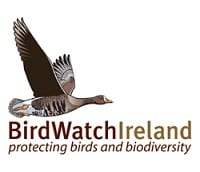
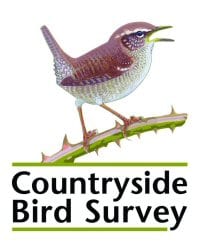

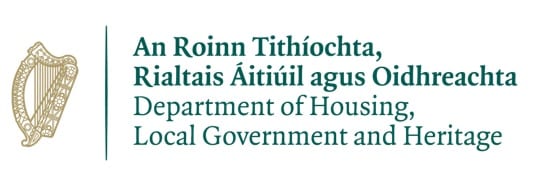
The Countryside Bird Survey (CBS) aims to monitor the status of common and widespread breeding bird populations in Ireland. Across many habitats, birds are regarded as good general indicators of the broad state of wildlife and of the countryside. Wild birds satisfy many of the criteria of being useful biodiversity indicators in that they occur higher up in food chains, are sensitive to environmental changes, are dispersed, diverse and mobile, and are relatively easy to census and collect data using well-developed and standardised methods. Using CBS data, we calculate trends of individual species (click here) that occur in 30 survey squares or more each year, on average, over the lifetime of the survey. We also combine these trends to produces indicators which provide an overview of how bird populations are doing more broadly over time. See below to learn more about the Irish ‘Common Bird Index’ and the Irish ‘Common Farmland Bird Index’. While these indicators are useful, it is important to be aware of their strengths and constraints when making inferences from them.
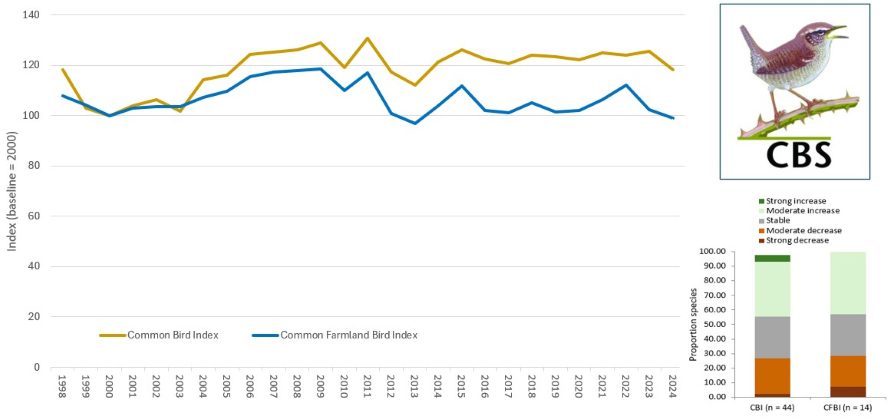
The Common Bird Index (CBI) and Common Farmland Bird Index (CFBI) 1998 – 2024.
Irish Common Bird Index (CBI) 1998 – 2024
The Irish Common Bird Index (CBI) was based on 44 common and widespread breeding birds which are monitored as part of the CBS. This indicator has increased overall (1998 – 2024), with the 2024 index at 118% of the baseline index (2000), meaning that, on average, the population sizes of species included in the indicator has increased by 18 per cent. Overall, there have been increases in 18 species, declines in 12 species with the remaining 14 constituent species showing stable trends throughout the course of the CBS.
The 44 bird species included in the Common Bird Index are: Buzzard, Kestrel, Woodpigeon, Collared Dove, Cuckoo, Swift, Skylark, Sand Martin, Swallow, House Martin, Meadow Pipit, Grey Wagtail, Pied Wagtail, Wren, Dunnock, Robin, Stonechat, Blackbird, Song Thrush, Mistle Thrush, Grasshopper Warbler, Sedge Warbler, Whitethroat, Blackcap, Chiffchaff, Willow Warbler, Goldcrest, Long-tailed Tit, Coal Tit, Blue Tit, Great Tit, Magpie, Jackdaw, Hooded Crow, Raven, House Sparrow, Chaffinch, Greenfinch, Goldfinch, Linnet, Lesser Redpoll, Bullfinch, Yellowhammer and Reed Bunting.
Because we only include species that occur on average in 30 survey squares or more per year over the lifetime of the survey, the Common Bird Index represents our most commonly occurring bird species. The following species included previously, are no longer included due to their occurrence being below the required threshold: Sparrowhawk, Stock Dove, Spotted Flycatcher, Wheatear, Treecreeper, Jay and Siskin.
Common Farmland Bird Index (1998 – 2024)
The Common Farmland Bird Index (CFBI) was based on 14 breeding farmland birds which are monitored by the CBS. The CFBI in 2024 was 99% of the baseline index in 2000, representing a decrease of 1% relative to the baseline. Among the constituent farmland bird species, increases were shown in 6 species, declines observed for 4 species, while 4 species were stable.
The 14 species included in the Irish Common Farmland Bird Index are: Kestrel, Woodpigeon, Swallow, Pied Wagtail, Stonechat, Magpie, Jackdaw, Hooded Crow, House Sparrow, Chaffinch, Greenfinch, Goldfinch, Linnet, Yellowhammer.
Because we only include species that occur on average in 30 survey squares or more per year over the lifetime of the survey, the Common Farmland Bird Index represents our most commonly occurring farmland bird species. There are several other Irish farmland bird species that could have been included in a farmland bird index, but these species are now too scarce. Examples include Curlew and Lapwing, and the now-extinct Corn Bunting.
Key Points for the Interpretation of these Indicators
-
- Time Period: The indicators reflect the period of time that the CBS has been in operation 1998-2024. These recent wild bird indicators should be viewed with caution and seen against the backdrop of significant declines that occurred in the 1970s and 1980s in Ireland and across Europe, before the CBS began (see the 2007-2011 Bird Atlas (Balmer et al. 2013); Birds of Conservation Concern in Ireland (Gilbert et al. 2021) for more.
- Historic Declines: In many cases, population increases for species should be viewed as the recovery of populations rather than increases per se. See below for examples of similar indicators from both the UK and Europe. These indicators cover a larger amount of time than those from Ireland and provide an indication as to the ‘height’ from which Irish species had fallen from before regular annual monitoring through CBS began.
- Species Variation: It is important to remember that the indicator is an aggregate of individual species indices and hence masks a lot of variation among individual species and groups of species. Therefore, increases in some species and decreases in other species can balance one another.
- Population Size: These indicators do not take account of population size, so a 50% decrease in one species would effectively be cancelled out by a 50% increase in another, regardless of whether one of those species is much more numerous than the other. In this way common species (e.g. Robins, Blackbirds) do not dominate the trends over species that exist at lower densities (e.g. birds of prey).
- Rare Species or species that have declined: It should be borne in mind that these indicators are based on data from common and widespread breeding bird species only. Certain species groupings, for example, breeding wading birds and some birds of prey are not included due to lack of data (do not meet the 30+ square average threshold for inclusion in analyses). So the indicators do not reflect the trends of rare/scare species or species that have declined in number to such an extent that they are no longer common and widespread in the countryside. Farmland bird species which were once widespread but are now rare include Grey Partridge, Barn Owl, Lapwing, Curlew, Corncrake, Twite and Whinchat. Large-scale declines of these species took place during the 1970s and 1980s. The 40-year change in breeding distribution published in the 2007-2011 Bird Atlas are as follows: Grey Partridge (-95%), Barn Owl (-47%), Lapwing (-53%), Curlew (-78%), Corncrake (-91%), Twite (-80%) and Whinchat (-76%)[1]. The Corn Bunting is included in similar indicators elsewhere (UK, Europe) but went extinct in Ireland in the early 1990’s.
[1] Balmer, D.E., Gillings, S., Caffrey, B.J., Swann, R.L., Downie, I.S. & Fuller, R.J. (2013) Bird Atlas 2007-11: the breeding and wintering birds of Britain and Ireland. BTO Books, Thetford.
- Farmland Species: 14 species are included in the Irish Common Farmland Bird Index. However, this includes many generalist species and very few farmland specialist species. The reason for this is largely down to island biogeography, and the poor status of some of our farmland breeding birds, many of which are now too scarce to be monitored through the CBS. As such, given that this indicator represents common Irish farmland bird species only, this is an important point to note.
- Habitat Representation: The choice of grid squares to be surveyed through the CBS is randomised, although the survey is stratified by region, which provides balance in this respect. However, certain habitats are under-represented including upland blanket bog. The CBS trends for species that prefer these under-represented habitats in CBS may therefore be biased, with knock-on effects for the accuracy of indicators that include these species.
Context from the UK and Europe
The Common Bird and Common Farmland Bird Indicators for Ireland can only be calculated since 1998, when the CBS began. Significant declines in species occurred in the 1970’s and 1980’s in particular, as well as the 1990’s, before Irish data are available. We can look at the indicators from the UK and Europe to get an idea of the likely trajectory of Irish bird populations pre-1998.
Indicators from both the UK and Europe include species not included in the Irish indicators, some of which breed in Ireland but their numbers and distributions are so low that they are not adequately monitored through CBS. The more positive trend in the Irish Common Farmland Bird Index compared to the UK and European counterparts may be at least partly explained because of the species not included in the Irish Index.
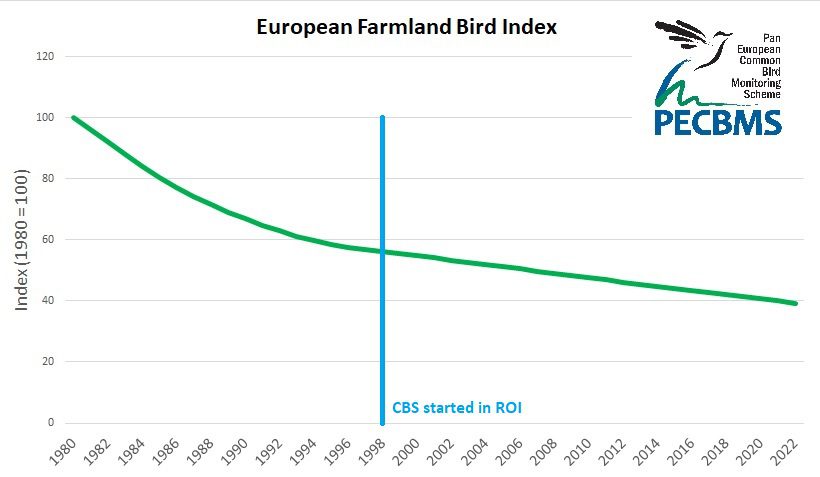
European Farmland Bird Index, via the Pan-European Common Bird Monitoring Scheme (PECBMS).
The European Farmland Bird Index stretches back to 1980, so provides an indication of the trends of farmland birds across Europe for nearly 20 years before the CBS started in Ireland. The European Farmland Bird Index includes a larger number of species than the Irish Farmland Bird Index. In the case of some of these species, they currently exist in such low numbers, density and such restricted distribution in Ireland that they can’t be included in the Irish index.
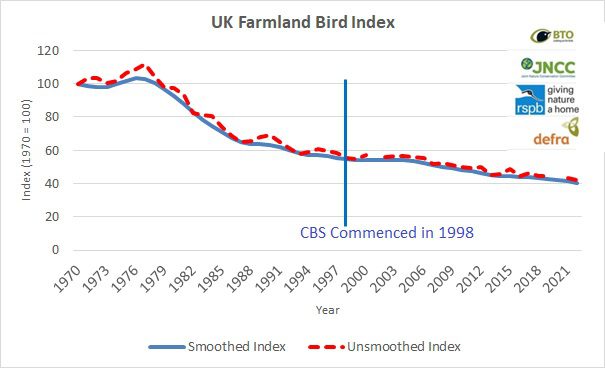
UK Farmland Bird Index, via BTO, DEFRA, JNCC, RSPB.
Full details about the UK Farmland Bird Index can be found on the BTO Website here, and the UK government website here.
The UK Farmland Bird Index stretches back to 1970, so provides an indication of the trends of farmland birds in the UK for nearly 30 years before CBS started in Ireland. The UK Farmland Bird Index includes a wider suite of species than the Irish Farmland Bird Index, and although many of these species are recorded in Ireland, they are not present in high enough densities to meet the threshold for analysis here. The UK farmland bird index contains data for 19 species, consisting of 12 farmland specialists and 7 generalists. Of those 19 species, only three do not occur in Ireland, all of which are farmland specialists: Corn bunting (recently extinct in Ireland), Turtle Dove (former rare regular breeder in Ireland) and Yellow Wagtail (irregular breeder in Ireland). The UK farmland bird index also includes farmland specialists still present in Ireland but not included in the Irish Common Farmland Bird index, such as Tree Sparrow, Lapwing and Grey Partridge, which are all found in fewer than 30 CBS squares.
According to the JNCC report on the UK farmland bird index (available here), “In 2022 the UK farmland bird index was 60% below its 1970 value. The decline has continued at a slower rate in the short-term; showing a decline of 8%.’’ The majority of this decline occurred between the late 1970s and the 1980s largely due to the negative impact of rapid changes in farmland management during this period. The decline has continued at a slower rate more recently. It is likely that the pre-CBS trend for Irish farmland birds would have followed a similar trajectory over a similar timeline.

